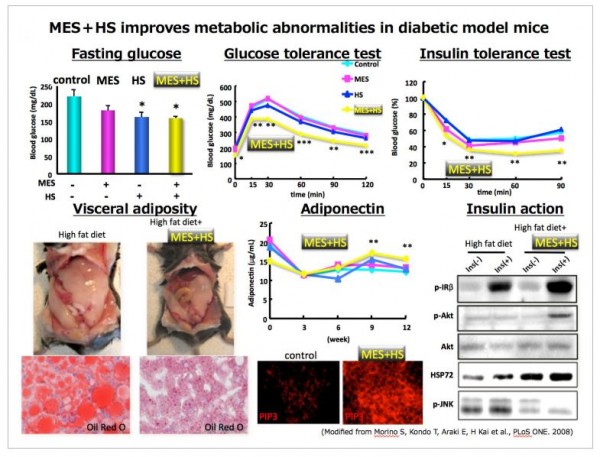Wearable Medical Device for Type 2 Diabetes Effective vs Visceral Fat
| Arthur Dominic Villasanta | | Nov 12, 2016 12:16 AM EST |
(Photo : Dr. Tatsuya Kondo) Mild electric stimulation (MES) & heat shock (HS) improves metabolic abnormalities in the diabetic mouse model.
A new wearable medical device developed by Kumamoto University in Japan has been found to trigger the loss of dangerous visceral fat and improve blood glucose (sugar).
Visceral fat is stored around a person's internal organs in his abdominal region, including the liver, pancreas and intestines. Too much visceral fat can interfere with how a liver functions and interrupt normal hormonal communications between your vital organs.
Like Us on Facebook
This can lead to insulin resistance (the beginning of diabetes), high blood pressure, high cholesterol levels and a higher risk for developing heart disease. Type 2 diabetes is a disease of systemic organ failure due to chronic hyperglycemia and inflammation from the accumulation of excess visceral fat.
The heat shock response (HSR) is activated as a response to stress in the human body, but its function decreases in those with type 2 diabetes.
A research team from Kumamoto University found that restoring the function of HSP72, the main protein of HSR, improved glucose-related abnormalities. The team also discovered that a suitable combination of mild electrical stimulation (MES) with heat shock (HS) activated HSP72 more efficiently.
Researchers developed a belt-type medical device that uses a special type of rubber to transmit MES and HS at the same time.
They then performed a clinical trial of MES + HS on 40 obese men suffering from type 2 diabetes. Results showed a decrease fasting glucose levels, a loss of visceral fat, improve insulin resistance and a significant (-0.43%) improvement in glycated hemoglobin (HbA1c) values.
About half of all subjects (52.5%) achieved less than 7.0% HbA1c, which is a treatment goal for diabetes. The first trial showed that activation of the HSR produced a large therapeutic effect.
In the next clinical trial, 60 obese patients with type 2 diabetes from both genders were given a 12-week treatment with the belt-shaped MES+HS medical device.
Trial subjects received treatments for 60 minutes each time, and were separated into three groups of 2, 4, and 7 treatments per week. This determined the most effective treatment frequency.
The reduction in the visceral fat area was 5.37 sq. cm in the 2 treatment per week group, 14.24 sq. cm in the 4 per week group and 16.45 sq. cm in the 7 per week group.
Declines in HbA1c were 0.10%, 0.36%, and 0.65% in the 2, 4, and 7 treatment-per-week groups respectively.
Improvements in chronic inflammation, fatty liver markers, renal function and lipid profile were also shown. Adding the MES+HS treatment to a DPP-4 inhibitor, which is the most often used therapeutic drug for diabetes in Japan, showed an even stronger blood glucose improvement.
"This device is very easy to use since it simply attaches to the abdomen, and it has a low-impact on the patient. One can expect the effects to be similar to exercise therapy," said Dr. Tatsuya Kondo, who lead the research.
"Even in patients who have difficulty exercising, such as those who are overweight, elderly, or have some form of disability, this device can be expected to provide acceptable treatment in addition to conventional diabetic medical care."
This research was posted online in the nature.com journal Scientific Reports on Oct. 19.
Tagsvisceral fat, Kumamoto University, Type 2 diabetes, heat shock response, mild electrical stimulation, obese men
©2015 Chinatopix All rights reserved. Do not reproduce without permission
 World's Smallest Magnifying Glass can see Chemical Bonds between Atoms
World's Smallest Magnifying Glass can see Chemical Bonds between Atoms Verlinde’s ‘Emergent Gravity’ Theory Dismisses Gravity as a Fundamental Force
Verlinde’s ‘Emergent Gravity’ Theory Dismisses Gravity as a Fundamental Force Expensive New Cancer Drugs have Little Effect on Survival of Many Cancer Patients, says New Study
Expensive New Cancer Drugs have Little Effect on Survival of Many Cancer Patients, says New Study Astronomers Meet to Finalize the ‘Square Kilometer Array,’ the World’s Largest Radio Telescope
Astronomers Meet to Finalize the ‘Square Kilometer Array,’ the World’s Largest Radio Telescope
EDITOR'S PICKS
-

Did the Trump administration just announce plans for a trade war with ‘hostile’ China and Russia?
-

US Senate passes Taiwan travel bill slammed by China
-

As Yan Sihong’s family grieves, here are other Chinese students who went missing abroad. Some have never been found
-

Beijing blasts Western critics who ‘smear China’ with the term sharp power
-

China Envoy Seeks to Defuse Tensions With U.S. as a Trade War Brews
-

Singapore's Deputy PM Provides Bitcoin Vote of Confidence Amid China's Blanket Bans
-

China warns investors over risks in overseas virtual currency trading
-

Chinese government most trustworthy: survey
-

Kashima Antlers On Course For Back-To-Back Titles
MOST POPULAR
LATEST NEWS
Zhou Yongkang: China's Former Security Chief Sentenced to Life in Prison

China's former Chief of the Ministry of Public Security, Zhou Yongkang, has been given a life sentence after he was found guilty of abusing his office, bribery and deliberately ... Full Article
TRENDING STORY

China Pork Prices Expected to Stabilize As The Supplies Recover

Elephone P9000 Smartphone is now on Sale on Amazon India

There's a Big Chance Cliffhangers Won't Still Be Resolved When Grey's Anatomy Season 13 Returns

Supreme Court Ruled on Samsung vs Apple Dispute for Patent Infringement

Microsoft Surface Pro 5 Rumors and Release Date: What is the Latest?










